Sep 3, 2020
On the road to safety
When most people began staying at home during the springtime height of the COVID-19 pandemic in Massachusetts, Sean O’Brien, the president of Teamsters Local 25, was working hard to make sure his essential workers were safe as they were on the job preparing and delivering many of the goods that made being homebound tolerable.
“The biggest thing for us was making sure there was a safe working environment and that our members had the necessary tools and protections to keep safe,” O’Brien said.

Workers packing grocery store trucks, delivering packages, or collecting trash did not have the option to sit out their jobs or work from home, he noted. Those early months forged a vigilant spirit in the union as the pandemic has stretched into the fall.
The biggest concern is always whether there is going to be an uptick and, if so, what are we going to do to protect ourselves better?
- O’Brien said.
The Bay State was one of the places hit hardest when the virus first reached the United States. During the surge, about 8% of Local 25’s 12,000 members tested positive for the virus. Two members lost their lives.
“The deaths are tragic,” O’Brien said, noting Teamsters were in environments such as warehouses and on delivery routes that put them in contact with large numbers of people. “We were afraid it was going to be more, a much, much higher rate.”
Throughout the pandemic, unions like the Teamsters have worked with employers to get personal protective equipment for members. The union also has educated its members to make sure they are wearing masks, sanitizing their hands frequently, and taking the steps needed to stay safe on the job.
“Everything is different now. The work we once knew will probably not be the work we will see again,” the Teamsters’ president said. “The masks are challenging at times. When you’re a delivery driver and you’re working all day and moving, it’s a little constricting. But at the end of the day, it’s investing in keeping yourself healthy.”
Protecting workers’ emotional wellbeing has also been top of mind. O’Brien said members have dealt with the stress of losing loved ones to COVID-19 or battled with the virus themselves. Even those who are healthy and working might be putting in 70, 80, or more hours per week.
“It takes a toll on people and it takes a toll on their families,” he said. “We have a mental health division that is active in providing as much support as possible.”
Keeping essential workers healthy is a major focus, but so are the relatively small percentage of workers in fields that are not deemed essential. Teamsters’ members who set up trade shows, work in the motion picture industry, or provide support services at the airport were all forced off the job and the work needed has dwindled.
“If some of these industries don’t come back, where do we transition these folks? Do we transition them into essential jobs?” O’Brien said. “That’s a challenge we are facing right now.”
The trade show workers were pressed into service for one vital job: Over the course of just five days in April, Teamsters’ workers helped transition the Boston Convention and Exhibition Center into a 1,000-bed field hospital to ease the pressure on local hospitals as the number of COVID-19 patients began to spike.

O’Brien sees his role and the role of other unions during this crisis as the latest in a long journey to ensure worker protections in tough times, a journey marked by Labor Day every year.
Pandemics and crises don’t discriminate, and they are always going to be around. The messages we send to our members right now: follow the guidelines, wear a mask, sanitize your hands.
- O’Brien said.
Did you find this article informative?
All Coverage content can be reprinted for free.
Read more here.
PHOTO OF SEAN O'BRIEN BY FAITH NINIVAGGI, PHOTO OF BOSTON HOPE BY MICHAEL GRIMMETT & US MILITARY

